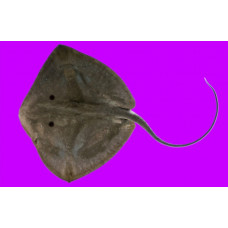Latin name
Bathytoshia lata
Other name
Brown stingray or Hawaiian stingray.
Identification
The pectoral fins of the Broad stingray are fused to the head, forming a rhombic flattened disc, almost a quarter of the length wide, with the anterior margin converging at an obtuse angle. The snout is rounded, with the tip projecting slightly beyond the edge of the disc. Spiracles behind the eyes. On the ventral surface of the disc are 5 gill slits, mouth and nostrils. A flap of skin with a fringed lower margin runs between the nostrils. The mouth is arched, with 5-6 protuberances at the base of the mouth, the two outermost being shallower than the others. The teeth are staggered and form a flat surface. On the dorsal surface, in the central part of the caudal peduncle, there is a serrated spine connected by ducts to the venom gland. Sometimes stingrays have two spines. Periodically the sting is broken off and a new one grows in its place. Behind the spine on the caudal peduncle is a ventral skin fold.
Large rays have 3 large plaques on the middle part of the back, the tail is dotted with small scales making it rough. There is an irregular row of conical spines along the sides of the tail, with several large flat plaques in front of the main spine.
Features of fish fins
The pelvic fins of this species are small and rounded. The whip-shaped tail is 2 times longer than the disc.
Fish colouring
Colour of dorsal surface of disc smooth olive or brown. Ventral surface of disc white.
Distribution
Widespread in the waters around the Hawaiian Islands.
Habitat
They are bottom dwellers. They are found in bays with muddy or sedimentary bottoms and coral reefs at depths from 2.5 to 357 metres. They are most commonly found deeper than 15 metres.
Size
The Broad Stingray has a maximum recorded drive width of 1.5m and weighs 53kg.
Behavior
Broad stingrays are generally inactive during the day, spending most of their time on the bottom, buried under a layer of sediment. Studies using tagging have shown that stingrays patrol an average area of 0.83 km² at night, while their daytime activity area is only 0.12 km². Stingrays do not stay in one place. They are most active 2 hours after sunset and 2 hours before dawn. They are more active in summer when the water temperature is higher. Tides do not have a significant effect on their behaviour as they live in deep water.
Food and feeding habits
They prey mainly on benthic crustaceans, polychaetes and bony fish. They dig large holes to reach prey buried in the ground. They are sometimes followed by Carangidae. Stingrays like to hunt at the edge of the reef where parrotfish, guban, gobies, etc. hide at night.
Reproduction
The Broad stingray is an egg-laying fish. Embryos develop in the womb and feed on egg yolk and histotrophs.
Fishing
This species of stingray is not a target fishery.
Relationship with a person
The habitat of these rays is partly within marine protected areas.
| Classification | |
| Phylum | Chordata |
| Class | Chondrichthyes |
| Squad | Myliobatiformes |
| Family | Dasyatidae |
| Genus | Bathytoshia |
| Species | B. lata |
| Features | |
| Conservation status | Vulnerable |
| Habitat | Bottom |
| Life span, years | No information |
| Maximum body weight, kg | 53 |
| Maximum length, cm | 150 |
| Sailing speed, m/s | No information |
| Threat to people | Edible |
| Way of eating | Predator |
Broad stingray
Tags: broad stingray

